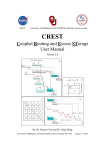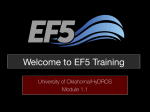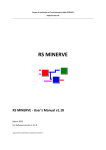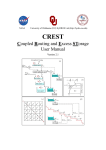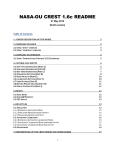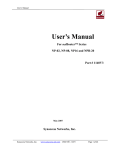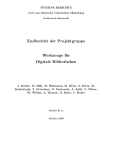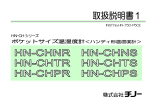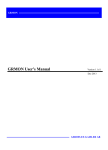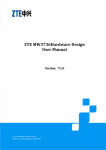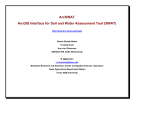Download User Manual - Hydrometeorology and Remote Sensing Laboratory
Transcript
Copyright © 2015 CREST V2.1 Fortran NASA University of Oklahoma (OU) HyDROS Lab (http://hydro.ou.edu) CREST Coupled Routing and Excess STorage User Manual © CREST Version 2.1-Fortran Real-Time Mode WMM W Forcasting Mode Canopy Incterception Discharge PET Infiltration Actual ET DEM, FDR, FAC, Slope Runoff Generation Soil Moisture Observed Discharge Actual ET Surface Runoff a-priori parameter Runoff Cell-toCell Routing Subsurface Runoff, PE Precipitation A W0 0 f/F 1.0 Atmospheric Forcing RS0 RainFact Stream Flood Assessment SCE-UA Input ΔW R Hydro-Processes Module Output Variable Infiltration Curve Function Module A R Ksat Surface RS Flow AET C RI0 B D Soil Layer Interflow RI Cell-To-Cell Surface Runoff Routing E F A B C D E F Cell-To-Cell Interflow Runoff Routing By Dr. Xianwu Xue, Dr. Yang Hong and Dr. Ke Zhang Copyright © Hydrometeorology and Remote Sensing Lab, National Weather Center, Norman, OK USA April 16, 2015 Copyright © 2015 CREST V2.1 Fortran Cover: CREST—Coupled Routing and Excess Storage User Manual Version 2.1 Brief Version History: 02/02/2011 Model was updated from CREST v1.6c to Modular Designed v2.0 with embedded SCE-UA (Developed by Dr. Xianwu Xue and Dr. Yang Hong) 01/11/2014 Model was updated to v2.0.3 10/31/2014 Model was updated to v2.1 Copyright © 2015 CREST V2.1 Fortran Table of Contents CREST ......................................................................................................................... 1 TABLE OF CONTENTS ..............................................................................................I 1 INTRODUCTION .................................................................................................... 1 2 NEW FEATURES OF CREST IN DIFFERENT VERSIONS FOR ADDITIONAL READING ................................................................................................................... 1 2.1 What’s New in CREST v2.1 .................................................................................. 1 2.2 New features in CREST v2.0 (also inherited by the CREST v2.1) ....................... 1 3 COMPILATIONS ................................................................................................... 13 3.1 Compiling on Linux Systems............................................................................... 13 3.2 Compiling on Window Systems........................................................................... 13 4 PROJECT FILE ..................................................................................................... 15 4.1 Model Area........................................................................................................... 15 4.2 Model Run Time Information .............................................................................. 16 4.3 Model Run Style .................................................................................................. 17 4.4 Routing Type ........................................................................................................ 17 4.5 Model Directory ................................................................................................... 19 4.6 OutPix Information .............................................................................................. 20 4.7 Outlet Information ............................................................................................... 21 4.8 Grid Outputs......................................................................................................... 21 4.9 Date Outputs ........................................................................................................ 23 4.10 Number of Lakes................................................................................................ 23 5 INPUTS & OUTPUTS ............................................................................................ 25 5.1 Basics Folder ........................................................................................................ 25 5.2 Params Folder ...................................................................................................... 32 I Copyright © 2015 CREST V2.1 Fortran 5.3 State Folder .......................................................................................................... 35 5.4 ICS Folder ............................................................................................................ 35 5.5 OBS Folder .......................................................................................................... 37 5.6 Calibs Folder ........................................................................................................ 37 5.7 Rains Folder ......................................................................................................... 41 5.8 PETs Folder .......................................................................................................... 41 5.9 Results Folder ...................................................................................................... 41 6 RUN STYLES ......................................................................................................... 43 6.1 Simulation ............................................................................................................ 43 6.2 Automatic Calibration using SCE-UA ................................................................. 46 6.3 Simulation in real time mode ............................................................................... 49 6.4 Return Period mode ............................................................................................. 50 7 IMPLEMENTATION OF THE CREST MODEL FOR OTHER BASINS............ 53 8 CONTACT .............................................................................................................. 55 9 SELECTED CREST MODEL RELATED REFERENCES................................... 55 10 APPENDIX A LOOK-UP TABLES ...................................................................... 57 II Copyright © 2015 CREST V2.1 Fortran 1 Introduction The Coupled Routing and Excess STorage (CREST) distributed hydrological model is a hybrid modeling strategy that was jointly developed by the University of Oklahoma (http://hydro.ou.edu) and NASA SERVIR Project Team (www.servir.net). The CREST model was initially designed to provide real-time regional and global hydrological prediction by simultaneously modeling over multi-basins with significantly cost-effective computational efficiency (http://eos.ou.edu), however it is also very applicable for small to medium size basins at very high-resolutions. CREST simulates the spatiotemporal variation of water and energy fluxes and storages on a regular grid with the grid cell resolution being user-defined, thereby enabling multi-scale applications. The scalability of CREST simulations is accomplished through sub-grid scale representation of soil moisture storage capacity (using a variable infiltration curve) and multi-scale runoff generation processes (using multi-linear reservoirs). The representation of the primary water fluxes such as infiltration and routing are physically related to the spatially variable land surface characteristics (i.e., vegetation, soil type, and topography etc.). The runoff generation process and routing scheme are coupled, thus providing more realistic interactions between lower atmospheric boundary layers, terrestrial surface, and subsurface water. The above flexible modeling features and embedded automated calibration algorithms make the CREST a powerful yet cost-effective tool for distributed hydrological modeling and implementation at global, regional, basin, and small catchment scales. This user manual and the accompanying software package enable first-time users to test the model with a single basin example. Section 2 provides more information on new features of different model versions but users can jump to Section 3 for source code compilations or directly go to Section 4-6 to learn how to implement the model with the provided basin example. Then Section 7 will guide the user how to set up and calibrate the model in new study areas. For more guidance of CREST model implementation, please contact us or download the week-long training materials in Kenya from this link: http://hydro.ou.edu/research/crest/crest-model-training-materials/#crest_workshop. 1 Copyright © 2015 CREST V2.1 Fortran 2 New Features of CREST in different Versions for additional reading 2.1 What’s New in CREST v2.1 1) Updated the continuous multi-linear reservoir routing option (See Figure 5-5), with the Keyword RouteType for this routing option in order to compatible with the CREST Model v2.0 2) Make the “CalibMask” file optional. 3) Improved the modeling compatibility at multiple temporal scales, ranging from minute, hour, day, month and year. 4) Fixed the display of digital numbers using Star during the simulation/ calibration on the terminal interface and also in the log file 2.2 New features in CREST v2.0 (also inherited by the CREST v2.1) 2.2.1 Main Features of CREST v2.0 • A modular design framework to accommodate research, development and system enhancements (see Fig. 2(a) in Xue et al. (2013)) • Inclusion of the optimization scheme SCEUA to enable automatic calibration of the CREST model parameters (see Fig. 2(a) in Xue et al. (2013)) • QPF Forecast Function Mode was incorporated and applied in the NASA SERVIR Africa Project (https://www.servirglobal.net/EastAfrica/MapsData.aspx) • All the parameters in CREST v1.6c were classified into three types: Initial Conditions, Physical Parameters (to be derived by a-priori parameter method), and conceptual parameters (to be calibrated), some of the non-sensitive parameters were omitted (more details in user manual) • Model implementation with options of either spatially uniform, semi-distributed, or fully distributed parameterization schemes • A multi-site cascading calibration framework was used to calibrate the model using multi-site streamflow gauge data from upstream to downstream (Users 1 Copyright © 2015 CREST V2.1 Fortran should prepare the streamflow data) • Enhancement of the computation capability using matrix manipulation • Project file was used to replace the original control file, and users can pass the project file to the CREST model instead of putting both the crest model executable file and the control file under the same directory path. Additionally, the statements in the project file could be in any order and more flexible • The Model can write out all the output variables in any given time (spatially distributed data) and in any designated location (Time series) 2.2.2 Summary of the codes: • V1.6c Total: 2106 Lines • V2.0.00 Total: 8841 Lines Include: 5437 Lines of Main CREST 3403 Lines of CREST-UA 2.2.3 Framework and Modular Design of CREST Model Comparing to previous CREST v1.6c, the programming framework of CREST v2.0 was redesigned to better suit for distributed hydrological modeling. As shown in Figure 2-1 and Figure 2-2 (Xue et al. (2013)), CREST v2.0 includes more spatially distributed input data (including a prior parameters) and outputs more variables data. 2 Copyright © 2015 CREST V2.1 Fortran Figure 2-1 Programming Framework of CREST v2.0 3 Copyright © 2015 CREST V2.1 Fortran Figure 2-2 (a) The framework of the CREST model version 2.0 and (b) vertical profile of hydrological processes in a grid cell. 4 Copyright © 2015 CREST V2.1 Fortran 2.2.4 Organization of the Files and Folders The previous version CREST v1.6c puts all data information into “Control.txt” (Figure 2-3); this will make the control file too big when modelers want to add other parameters or data into the CREST. Additionally, when implementation of the model becomes complex, it will contain too many files under one file folder, causing unnecessary confusion and inconvenience to users or modelers. DDM.txt DEM.txt FAM.txt Basics Rain PET Control.txt Discharge Name.hyp.txt Exports Figure 2-3 Files’ and Folders’ Organization of CREST v1.6c In CREST v2.0, control file was 5 divided into “ProjectName.Project”, Copyright © 2015 CREST V2.1 Fortran “Parameters.txt”, “InitialConditions.txt” and “Calibrations.txt”. Each of four files is put in standalone folders, including other related data and files. Thus the “ProjectName.Project” file only contains the model’s input information and its configuration. This will enables user to build and modify these files easily. Figure 2-4 shows all the folders defined in CREST v2.0 based on their functionality. More detailed information of these folders will be discussed in following sections. Basics ICS Params OBS States ProjectName. Project Rain PET Results Calibs Figure 2-4 Files’ and Folders’ Organization of CREST v2.0 6 Copyright © 2015 CREST V2.1 Fortran 2.2.5 Comparison with CREST v1.6c Compare the simulation v1.6c v2.0.00 1 8.019 5.039 2 4.415 2.917 3 4.461 2.886 4 4.368 2.885 5 4.462 3.042 6 4.43 3.369 Ave 5.632 3.614 Compare the calibration Iteration Elapsed Time v1.6c 15795 8h 25min v2.0.00 3000 1h 46min Cascading(2Region) 3000 3h 35min NSCE Bias(%) CC 0.999988574 -0.00926862 0.99999502 One Region NSCE 0.990432 0.999989 0.999548 NSCE 0.999998757 NSCE Bias(%) -0.004382075 Bias(%) CC 0.999999408 CC 0.999548 0.371125 0.999816 Two Regions ( Upstream point (left), Outlet ( right)) Figure 2-5 Comparison of CREST v1.6c and v2.0 in the running efficiency 2.2.6 Pre-Process of CREST v2.0 Basics Data Inputs: Support More File Formats: ASC, TXT, DBIF, BIFFIT, TRMMRT, TRMMV6, TRMMV7, NMQBIN, ASBIMO, BIBIMO Flow Direction Map Support Both CNT flow direction codes and ArcGIS flow direction codes 7 Copyright © 2015 CREST V2.1 Fortran Figure 2-6 Flow Direction Coding Stream Map Omit TH parameter Slope Map Omit GM Parameter Make the mask, GridArea and AreaFactor maps to optional 2.2.7 Parameters Classification Table 2-1 Parameters in CREST v1.6 and v2.0 W0 SS0 SI0 Symbol (v1.6c) iWU iSO iSI Initial Value of Soil Moisture Initial value of Overland Reservoir Initial value of Interflow reservoir Ksat pFc the Soil saturate hydraulic conductivity RainFact WM B IM KE coeM Rain pWm B pIM/100 pKE coeM the multiplier on the precipitation field The Mean Water Capacity the exponent of the variable infiltration curve Impervious area ratio The factor to convert the PET to local actual overland runoff velocity coefficient expM expM overland flow speed exponent coeR River multiplier used to convert overland flow Module Symbol (v2.0) Initial Condition Physical Parameters Conceptual Parameters Description 8 Copyright © 2015 CREST V2.1 Fortran coeS Under KS KI LeakO LeakI (Omitted)/TH TH Adjustment Parameters (Omitted)/GM GM AreaFact speed to channel flow speed multiplier used to convert overland flow speed to interflow flow speed Overland reservoir Discharge Parameter Interflow Reservoir Discharge Parameter Threshold to determine which cells are river cells downstream cell is higher than the upstream downstream cell is a nodata/outside region cell multiplier that modifies the area of grid cells AreaC 2.2.8 Input Data Use ProjectName.Project as the main control file for CREST v2.0, Use “#” in the beginning of the line as the comments, all of the inputs in the project file can be in any order. In the CREST v2.0, there are two files to control the initial conditions and parameters respectively, they can input both uniform value and/or distributed values. For the observed streamflow data, .csv format same as Excel are used to convenient to be prepared by Excel. Figure 2-7 Example of the observed streamflow file For the Precipitation and Potential Evapotranspiration data, the users can use any formats and CREST v2.0 can clip the area automatically when the data area is different with the defined research area in project file. So ClipRe parameter in CRESt v1.6c is 9 Copyright © 2015 CREST V2.1 Fortran omitted. 2.2.9 Mode Structure Divide the processes into subroutines to make the codes easy to understand and modification a) Canopy Interception b) Potential Evapotranspiration c) Runoff Generation d) Actual Evapotranspiration e) Runoff Route Encapsulate the variables into different modules and its types, and add “g_” as the prefix to strength the code readable 2.2.10 Output Data • Output the Outlet’s data • Output the all the inner points’ data including its upstream area’s average Rain and PET • Output the specified state variables’ data • Output the specified time's data • Automatically compute the NSCE, Bias and CC when outlet and inner pints having observation data • The output data files use their data type as prefix to make the user know them easily 2.2.11 Output & Post-Process CSV format is used for the outlet and any location output results. 10 Copyright © 2015 CREST V2.1 Fortran 2.2.12 Calibration Optimize the distributed parameters using SCE-UA and Matrix Manipulation Figure 2-8 Matrix Manipulation Using cascading strategy calibrate the model automatically using different regions with different parameters’ dataset based on the calibration stations’ region number 2.2.13 Fix some bugs • Take TH and FAC for example • FAC has two means: 1. Number of the upstream grids 2. Upstream basin’s area From codes, TH is the area, not the number, so should sum the upstream grids area 11 Copyright © 2015 CREST V2.1 Fortran 3 Compilations This CREST model version is written in FORTRAN, and will run under most operating systems. It has been successfully implemented on Pentium & PC based systems (Microsoft Windows and Linux). It is not necessary to modify the source code of CREST in order to change settings or switch to other basins. In CREST v1.6, the control file with a default name of “control.txt” and basic grids dictate the necessary settings for running the model. However, CREST V2.1 control file uses “ProjectName.Project” instead of the “control.txt”. Users are recommended to name the control file “ProjectName.project” as specific projects if you have multiple projects using the model in same file system. 3.1 Compiling on Linux Systems The Linux/Unix operating systems are case sensitive. So when you compile CREST model, you must pay attention to the name and extension of the default file. 3.1.1 Using “ifort” compiler Compiling CREST is easy with FORTRAN compiler. The source code of CREST model is contained in a single file for ease of use. As such, in order to compile CREST using ifort all you need to do is to type a simple command line "ifort crest.for –o crest.lx". This will compile the CREST FORTRAN source code file into an executable named "crest.lx". The Intel FORTRAN compiler has many other command line arguments to enable additional optimizations and other features. If you want a full list and description of how to use ifort, please consult the Intel FORTRAN compiler user manual. 3.2 Compiling on Window Systems 3.2.1 Using “Compaq Visual FORTRAN” (CVF) compiler Compiling CREST is also very easy using CVF on Windows platforms, you can just open the “crest.for” by CVF, and then compile it, and finally, “crest.exe” will be created. 13 Copyright © 2015 CREST V2.1 Fortran If you want a full list and description of how to use CVF, please consult the Compaq Visual FORTRAN compiler user manual. 14 Copyright © 2015 CREST V2.1 Fortran 4 Project File The file “ProjectName.Project” contains the information about Model Area, Run Time Information, Configuration Directory, Run Style, Outputs Information for Specified Pixels and Outlet, Outputs States and Outputs Date, and it also contains file assignments and their formats (One line for each assignment or information). The “ProjectName” is the name of the project, when run CREST v2.1 on Linux/Unix operating system, the extension of project file should write as “Project”, not “project” or others. Note: The statement in the project file can be listed in any order, but the keywords should not be changed. The format of the statement is: Keyword = Value The statement appearing on the same line should be space- or tab-separated. Comment lines must have a pound sign, #, in the first column. Comment for the statement in the line must be placed after Value and be sure to leave at least one space or tab between the Value and the comments. Keyword is not case sensitive. 4.1 Model Area Figure 4-1 Sample Model Area in “ProjectName.Project” 15 Copyright © 2015 CREST V2.1 Fortran NCols: Number of cell columns; NRows: Number of cell rows. XLLCorner : X coordinate of the origin (by lower left corner of the cell). YLLCorner : Y coordinate of the origin (by lower left corner of the cell). CellSize: Cell Size. NoData_Value: The input values to be No Data in the input/output map file. 4.2 Model Run Time Information Figure 4-2 Sample Model Run Time Information in “ProjectName.Project” TimeMark: The unit of time step. The possible units are “y” (year), “m” (month), “d” (day), “h” (hour), “u” (minute), “s” (second). TimeStep: Time Step. StartDate: Start date of the simulation, its format is defined as “yyyymmddhhuuss”, the length is up to the time step unit, for example, “yyyy” when time step unit is “y”; “yyyymmddhhuuss” when time step unit is “s” LoadState: The mark for reading the state file. “yes” means user want to run the model by state files as initial value, “no” means the initial values are read determined by initial condition file. WarmupDate: Warm up date for the simulation, its format is defined the same as 16 Copyright © 2015 CREST V2.1 Fortran “StartDate”. EndDate: End date for the simulation, , its format is defined the same as “StartDate”. The mark for saving the state file. “yes” means user want to save SaveState: the state files when finished running the model, “no” means user does not want to save the state files.. 4.3 Model Run Style Figure 4-3 Sample Model Run Style in “ProjectName.Project” The run style “simu” means simulation; other possible run styles are “cali_SCEUA” (automatic calibration using SCE-UA method), “RealTime” (on line mode), and “repe” (return period) modes. 4.4 Routing Type Figure 4-4 Sample Routing Type in “ProjectName.Project” The routing component in CREST is based on a two-layer scheme describing overland runoff and interflow from one cell to the next one downstream, with consideration of open channel flow (Wang et al., 2011). In other words, the runoff in Cell A from interflow, overland flow and channel flow contribute to cells downstream D and F. We called this method as Jumped Linear Routing (Hereafter: JLR). JLR method provides a very efficient way for cell-by-cell routing. However, in some application, if the Grid Cell is very large and the time scale is very small, JLR will cause 17 Copyright © 2015 CREST V2.1 Fortran underestimates of the streamflow. So we developed another method to solve this problem: Continuous Linear Routing (Hereafter: CLR), this method will loop all the cells the water flowed during the time step. Please note that, CLR will spend more time than JLR in most of the application. Figure 4-5 Description of the JLR and CLR in CREST v2.1 18 Copyright © 2015 CREST V2.1 Fortran 4.5 Model Directory Figure 4-6 Sample Model Directory in “ProjectName.Project” As shown in Figure 3-3, CREST v2.1 divides the input and output data into 9 groups, each groups has a standalone folders, such as “Basics”, “Params”, “States”, “ICS”, “Rains”, “PET”, “Results”, “Calibs” and “OBS” (the name of the folder can be user-specified, but the its keyword is fixed). Each folder contains some files (detailed content will be introduced in the next chapter), the format of the folder means all or most of the files in this folder will use this format. The file possible formats of CREST v2.1 are "ASC", "TXT", "DBIF", "BIFFIT", "TRMMRT", "TRMMV6", "NMQBIN", "ASBIMO" and "BIBIMO". 19 Copyright © 2015 CREST V2.1 Fortran 4.6 OutPix Information Figure 4-7 Sample OutPix Information in “ProjectName.Project” NOutPixs: The number of output pixels OutPixColRow: OutPixColRow is specified if the pixel is relative to the basic grids or in latitude and longitude. A value of “yes” means the location of the pixels is a column and row, a value of “no” means the location is longitude and latitude. OutPixNameX: The name of the Xth Pixels. The value of “X” is up to NOutPixs (X = [1~ NOutPixs]). OutPixLongX: The longitude of the Xth Pixels when OutPixColRow is assigned “no”. OutPixLatiX: The latitude of the Xth Pixels when OutPixColRow is assigned “no”. OutPixColX: The Column of the Xth Pixels when OutPixColX is assigned “yes”. OutPixRowX: The Row of the Xth Pixels when OutPixColX is assigned “yes”. 20 Copyright © 2015 CREST V2.1 Fortran 4.7 Outlet Information Figure 4-8 Sample Outlet Information in “ProjectName.Project” HasOutlet: Whether have outlet or not, a value of “yes” means research area has an outlet, a value of “no” means have not. OutletColRow: OutletColRow is specified if the outlet is relative to the basic grids or in latitude and longitude. A value of “yes” means the outlet of the pixels is a column and row, a value of “no” means the outlet is longitude and latitude. OutletName: The name of the outlet Pixels. OutletLong: The longitude of the Outlet Pixels when OutletColRow is assigned “no”. OutletLati: The latitude of the Outlet Pixels when OutletColRow is assigned “no”. OutletCol: The Column of the Outlet Pixels when OutletColRow is assigned “yes”. OutletRow: The Row of the Outlet Pixels when OutletColRow is assigned “yes”. 4.8 Grid Outputs Grid Outputs is the control of 2-D grid-based output, “yes” means output and “no” means do not output. The run time of the model depends on the number of outputs. A faster CREST model runtime can be achieved by reducing the number of output variables. Output format is controlled by the ResultFormat in section 4.4. All outputs are spatially 21 Copyright © 2015 CREST V2.1 Fortran interpolated to the proper resolution and clipped to either the basic grids or the drainage area automatically. Figure 4-9 Sample Grid Outputs in “ProjectName.Project” GOVar_Rain: The input precipitation; unit is mm/hour. GOVar_PET: The input PET; unit is mm/hour. GOVar_EPOT: GoVar_PET*KE GOVar_EAct: The depth of simulated actual evapotranspiration; unit is mm/hour. GOVar_W: The depth of water filling the pore space bucket "WM" GOVar_SM: Soil Moisture, a percentage of the WM GOVar_W/WM GOVar_R: The simulated discharge of each grid cell; unit is m³/s. GOVar_ExcS: The depth of surface excess rain; unit is mm/hour. GOVar_ExcI: The depth of interflow excess rain; unit is mm/hour. GOVar_RS: The depth of overland flow; unit is mm/hour. GOVar_RI: The depth of interflow flow; unit is mm/hour. 22 and equals Copyright © 2015 CREST V2.1 Fortran 4.9 Date Outputs Figure 4-10 Sample Output Dates in “ProjectName.Project” Date Outputs is to be specified some dates what user is interested in. NumOfOutputDates: The Number of Output Date OutputDate_X: The Xth Date to output, The value of “X” is up to NumOfOutputDates (X = [1~ NumOfOutputDates]). 4.10 Number of Lakes Figure 4-11 Sample Number Lake in “ProjectName.Project” NumOfLakes is to be specified the number of Lakes in this research region. NumOfLakes: The Number of Lakes 23 Copyright © 2015 CREST V2.1 Fortran 5 Inputs & Outputs CREST v2.1 can read all the Grid file formats (such as "ASBIMO", "BIBIMO", "ASC", "TXT", "DBIF","BIFFIT", "TRMMRT", "TRMMV6" and "NMQBIN") and can clip the file automatically when this file is not equal to the extent defined in “ProjectName.Project”, so user does not need to extract the research area by themselves as long as your prepared input files have broader space domain. Note: Users can learn how to prepare the data using ArcGIS from the workshop Dr. Xianwu Xue hosted in Kenya, please click this link1 to access it. 5.1 Basics Folder This folder contains the basic file for the model, such as DEM file, FDR file (Flow Direction), FAC file (Flow Accumulation) and so on. 5.1.1 DEM File Required: Always Name: DEM.* Format: All Formats Purpose: Contains a digital elevation model of the basin area, with heights in meters Notes: 1 http://hydro.ou.edu/files/Crest_Workshops/Kenya_Xianwu_2012/DayTwo/Hands-on%20Session-Preparing%20Data%20For%20CREST%20Model.pdf 25 Copyright © 2015 CREST V2.1 Fortran The coordinate system of CREST v2.1 can use both Geographic Coordinate System and Projected Coordinate System (PCS) 5.1.2 FDR File Required: Always Name: FDR.* Format: All Formats Purpose: Contain a flow direction from each cell to its steepest downslope neighbor of the basin area. Notes: The coordinate system of FDR File should be same as DEM File. In the former version of CREST, direction coding only use the rule like Figure 5-1 (a) generated by “CNT”, however, most popular software (like ArcGIS) use the rule like Figure 5-1 (b), so CREST v2.1 uses both of the two rules. 8 1 7 6 5 2 32 3 16 4 8 (a) 64 1 4 (b) Figure 5-1 Flow Direction Coding 26 128 2 Copyright © 2015 CREST V2.1 Fortran 5.1.3 FAC File Required: Always Name: FAC.* Format: All Formats Purpose: Contains accumulation flow to each cell of the basin area. Notes: The coordinate system of FAC File should be same as DEM File. 5.1.4 Mask File Required: Optional If omitted If HasOutlet == “yes”, then CREST v2.1 will generate the mask filebased on Outlet location. If HasOutlet == “no”, then CREST v2.1 will generate the mask file based on NoData_Value in DEM file. Name: Mask.* Format: All Formats Purpose: 27 Copyright © 2015 CREST V2.1 Fortran Contains a mask of the basin, indicating which cells in the other terrain are inside the basin Notes: The coordinate system of Mask File should be same as DEM File. 5.1.5 GridArea File Required: Optional If omitted, CREST v2.1 will generate the GridArea file based on the coordinate system. Name: GridArea.* Format: All Formats Purpose: Contain the area of each cell in the basin Notes: The coordinate system of GridArea File should be same as DEM File. 5.1.6 AreaFact File Required: Optional If omitted, CREST v2.1 will assign AreaFact.file a uniform value (1.00). Name: AreaFact.* Format: All Formats 28 Copyright © 2015 CREST V2.1 Fortran Purpose: Contains the area of each cell in the basin Notes: The coordinate system of AreaFact File should be same as DEM File. 5.1.7 Stream File Required: Optional, however if Stream file is omitted, Stream.def must be required. If omitted, CREST v2.1 will read the threshold to determinate the stream from Stream.def. Name: Stream.* Format: All Formats Purpose: Contain the information to show whether each cell is the stream. Notes: The coordinate system of Stream File should be same as DEM File. 5.1.8 Stream.def File Required: Optional, however if Stream.def is omitted, Stream file must be required. Only use when Stream file omitted. Name: Stream.def Format: ASCII, only contain one value 29 Copyright © 2015 CREST V2.1 Fortran Purpose: Contain the threshold for determining the stream. Notes: Stream.def is used to compatible with the former version of CREST, instead of Th parameter in the former version of CREST. 5.1.9 Slope File Required: Optional If Slope omitted If Slope.def exists, CREST v2.1 will calculate the Slope like the former version. If Slope.def does not exist, CREST v2.1 will calculate the Slope automatically. Name: Slope.* Format: All Formats Purpose: Identify the rate of maximum change in DEM file from each cell. Notes: The coordinate system of Slope File should be same as DEM File. 5.1.10 Slope.def File Required: Optional 30 Copyright © 2015 CREST V2.1 Fortran Only use when Slope file omitted, CREST v2.1 will read this file. If Slope.def is omitted yet, CREST v2.1 will calculate the Slope automatically. Name: Slope.def Format: ASCII, only contain one value Purpose: Contain the threshold for determining the stream. Notes: Slope.def is used to compatible with the former version of CREST, instead of GM parameter in the former version of CREST. 5.1.11 Lake Mask File Required: Optional If NumOfLakes==0 then omitted Name: LakeMask.* Format: All Formats Purpose: Contains a mask of lakes in this region, indicating which cells is the lake Notes: The coordinate system of LakeMask File should be same as DEM File. 31 Copyright © 2015 CREST V2.1 Fortran 5.2 Params Folder This folder contains all the configuration and values of parameters for the model. There are total 18 parameters, classified into four types in this new version (see Table 5-1). CREST v2.1 puts the initial condition into ICS folder (will introduce later), TH and GM are optional control parameters, and AreaFact can be calculated by ArcGIS or other software, or by CREST v2.1 automatically. So, there are 12 essential parameters in CREST v2.1. The look up tables, the range and the default value of part/all of these parameters are listed in Appendices Table 10-1, Table 10-2 and Table 10-3. 32 Copyright © 2015 CREST V2.1 Fortran Table 5-1 Classification in CREST v2.1 vs v1.6c Module Initial condition Physical Parameters Conceptual Parameters Adjustment Parameters Symbol (v2.1) W0 SS0 SI0 Ksat RainFact WM B IM KE coeM expM Symbol (v1.6c) iWU iSO iSI pFc Rain pWm B pIM/100 pKE coeM expM coeR River coeS Under KS KI LeakO LeakI (Omitted)/TH TH (Omitted)/GM GM AreaFact AreaC Description Initial Value of Soil Moisture Initial value of Overland Reservoir Initial value of Interflow reservoir the Soil saturate hydraulic conductivity the multiplier on the precipitation field The Mean Water Capacity the exponent of the variable infiltration curve Impervious area ratio The factor to convert the PET to local actual overland runoff velocity coefficient overland flow speed exponent multiplier used to convert overland flow speed to channel flow speed multiplier used to convert overland flow speed to interflow flow speed Overland reservoir Discharge Parameter Interflow Reservoir Discharge Parameter Threshold to determine which cells are river cells downstream cell is higher than the upstream downstream cell is a nodata/outside region cell multiplier that modifies the area of grid cells 5.2.1 Parameters.txt File Required: Always Name: Parameters.txt Format: 33 Copyright © 2015 CREST V2.1 Fortran ASCII Purpose: Contain the configuration for all parameters in CREST v2.1 Notes: The statement in the “Parameters.txt” file can be listed in any order, but the keywords should not be changed. The format of the statement is: Keyword = Value Such as: SymbolType = Uniform/Distributed If SymbolType = Uniform then Symbol = Value Else Symbol.* file must be provided in the same folder. End if The statement appearing on the same line should be space- or tab-separated. Comment lines must have a pound sign, #, in the first column. Comment for the statement in the line must be placed after Value and be sure to leave at least one space or tab between the Value and the Comments. Keyword is not case sensitive. 5.2.2 “Sysmbol.*” File Required: Optional Only needed when this parameter’s style is Distributed. 34 Copyright © 2015 CREST V2.1 Fortran Name: ParameterName.* “ParameterName” possibly likes “Rain” Format: ASCII Purpose: Contain the configuration for all parameters in CREST v2.1 Notes: The file coordinate system of Slope File should be same as DEM File. 5.3 State Folder This folder contains the state files, such as “State_StartDate_SS0.*”, “State_StartDate_SI0.*”and “State_StartDate_W0.*” when LoadState = “yes”. When SaveState = “yes”, then “State_EndDate_SS0.*”, “State_EndDate_SI0.*”and “State_EndDate_W0.*” will be created after running the model. 5.4 ICS Folder This folder contains all the configuration and values of initial conditions for the mode. 5.4.1 InitialConditions.txt File Required: Always Name: InitialConditions.txt Format: ASCII 35 Copyright © 2015 CREST V2.1 Fortran Purpose: Contain the configuration for initial conditions in CREST v2.1 Notes: The statement in the “InitialConditions.txt” file can be listed in any order, but the keywords should not be changed. The format of the statement is: Keyword = Value Such as: SymbolType = Uniform/Distributed If SymbolType = Uniform then Symbol = Value Else Symbol.* file must be provided in the same folder. End if The Symbol includes “SS0”, “SI0” and “W0” (see Table 5-1). The statement appearing on the same line should be space- or tab-separated. Comment lines must have a pound sign, #, in the first column. Comment for the statement in the line must be placed after Value and be sure to leave at least one space or tab between the Value and the Comments. Keyword is not case sensitive. 5.4.2 “Sysmbol.*” File Required: Optional Only needed when this parameter’s style is Distributed. Name: ParameterName.* 36 Copyright © 2015 CREST V2.1 Fortran “ParameterName” possibly likes “Rain” Format: ASCII Purpose: Contain the configuration for all parameters in CREST v2.1 Notes: The file coordinate system of Slope File should be same as DEM File. 5.5 OBS Folder This folder contains all the observed runoff data for the model calibration or verification. The file’s name is name as “OutPixNameX_Obs.csv” and/or “OutletName_Obs.csv” (“.csv” is the comma delimited file). “OutPixNameX” and “OutletName” are the same as the project file. 5.6 Calibs Folder This folder contains all the configuration and values of calibration for the model. Note: Users can learn how to calibration the model using ArcGIS from the workshop Dr. Xianwu Xue hosted in Kenya, please click this link2 to access it. 5.6.1 Calibrations.txt File Required: Always Name: Calibrations.txt Format: 2 http://hydro.ou.edu/files/Crest_Workshops/Kenya_Xianwu_2012/DayTwo/Hands-on%20Session-Calibrate%20the%20CREST%20Model.pdf 37 Copyright © 2015 CREST V2.1 Fortran ASCII Purpose: Contain the configuration for calibrations in CREST v2.1 Notes: The statement in the “Calibrations.txt” file can be listed in any order, but the keywords should not be changed. The format of the statement is: Keyword = Value The statement appearing on the same line should be space- or tab-separated. Comment lines must have a pound sign, #, in the first column. Comment for the statement in the line must be placed after Value and be sure to leave at least one space or tab between the Value and the Comments. Keyword is not case sensitive. 38 Copyright © 2015 CREST V2.1 Fortran Figure 5-2 Sample of “Calibrations.txt” file 1. SCE-UA Parameters iseed: Initial random seed; maxn: Max no. of trials allowed before optimization is terminated kstop: Number of shuffling loops in which the criterion value must chang by the given percentage before optimization is terminated pcento: Percentage by which the criterion value must change in given number of shuffling loops ngs: Number of complexes in the initial population 2. Configuration for calibration NCalibStations: Number of Calibrated Stations IsColRow: Specified if the location of calibrated station is relative to the basic grids or in latitude and longitude. A value of “yes” means the outlet of the pixels is a column and row, a value of “no” means the outlet 39 Copyright © 2015 CREST V2.1 Fortran is longitude and latitude. 3. Configuration for Each Station Name_X: The name of the Xth station Value_X: The region value of the Xth station Long_X: The longitude of the Xth station when IsColRow is assigned “no”. Lati_X: The latitude of the Xth station when IsColRow is assigned “no”. Col_X: The Column of the Outlet Pixels when IsColRow is assigned “yes”. Row_X: The Row of the Outlet Pixels when IsColRow is assigned “yes”. Label_X: The minimum, initial value and maximum of the Xth Label parameter for calibration. The label name can see Table 5-1Error! Reference source not found.. The format of this statement is: Label_X = Min Value Max X is the number of station to calibration. Only required when user want to calibrate this parameter. 5.6.2 CalibMask.* File Required: Optional Name: CalibMask.* Format: All Formats Purpose: Contain the order number for calibration, when have more than ONE calibrated station. The number depends on the regional number of each station. Notes: The coordinate system of CalibMask File should be same as DEM File. 40 Copyright © 2015 CREST V2.1 Fortran 5.7 Rains Folder This folder contains the precipitation data, the format of file in the folder depending on the RainFormat specified in the “ProjectName.Project” file. The CREST model can clip the region defined in the “ProjectName.Project” file automatically. 5.8 PETs Folder This folder contains the potential evaporation data, the format of file in the folder depending on the PETFormat specified in the “ProjectName.Project” file; and the CREST v2.1 can clip the region defined in the “ProjectName.Project” file automatically. 5.9 Results Folder This folder contains the output files, the format of file in the folder depending on the ResultFormat specified in the “ProjectName.Project” file. 41 Copyright © 2015 CREST V2.1 Fortran 6 Run Styles Different run styles have different combinations of outputs; the following section will introduce the outputs for each style. 6.1 Simulation 6.1.1 Running in Simulation Mode To run the model in simulation mode the run style in the project file must be set to "simu". Precipitation data and PET data are also needed for the simulation period. By default CREST reads the “ProjectName.Project” located in the current working directory. However, as of CREST v2.1 it is possible to specify the project file name as a command line option to the CREST executable. 43 Copyright © 2015 CREST V2.1 Fortran 6.1.2 Simulation Mode Standard Outputs Figure 6-1 Output results in screen for Simulation mode The 1 line is the comment for requiring user to enter the name of the project file. The 2 line is the user-typed line for the name and path of the project file. The 3 line is the separation line. The 4~6 line is the information of the CREST v2.1. The 7 line is the separation line. The 8 line is the start date and time for running the model. The 9 line is the separation line. The 10~21 line is the reading and writing data. The 22 line is the separation line. The 23 line is the information for running style to the current running model. The 24~32 line is the reading and writing data. The 33 line is the separation line. 44 Copyright © 2015 CREST V2.1 Fortran The 34~37 line is the output results. The 38 line is the separation line. The 39 line is the end date and time for running the model. The 40 line is the elapsed run time for running the model. 6.1.3 Simulation Mode File Outputs Besides output the results to the screen, CREST v2.1 also outputs the results to a log file in the same folder as project file, “ProjectName_YYYY.MM.DD-HH.UU.SS_CREST.log”, named for as example: “NZoia_2011.02.07-00.33.05_CREST.log”. The time in this file’s name depending on the date and time the model is running. The log file will help the user record all the things the user wants to see, even on the Linux operating system. There are many files to output when the model is running in the simulation mode: Mask.*: When the mask file is omitted in the basics folder. Slope.*: When the slope file is omitted in the basics folder. Outlet_OutletName_Mask.*: The mask file for the specified outlet. Outlet_OutletName_Results.csv: The results for the outlet location (Table 6-1). (Regional Mean Value based on the Outlet_OutletName_Mask.*) Table 6-1 Sample of Outlet_OutletName_Results.csv DateTime Rain PET EPot EAct W SM RS RI ExcS ExcI R RObs 2003/1/1 0:00 0 0.215 0.043 0.023 38.451 0.534 1.114 1.452 0 0 0.605 0.605 2003/1/1 3:00 0 0.215 0.043 0.023 38.382 0.533 1.112 1.452 0 0 2.359 2.359 2003/1/1 6:00 0.009 0.215 0.043 0.024 38.331 0.533 1.107 1.452 0 0.002 3.375 3.375 2003/1/1 9:00 0 0.215 0.043 0.023 38.263 0.532 1.1 1.452 0 0 4.655 4.655 2003/1/1 12:00 0 0.215 0.043 0.023 38.194 0.531 1.089 1.452 0 0 6.218 6.218 2003/1/1 15:00 0.889 0.215 0.043 0.03 39.705 0.552 1.15 1.508 0.131 0.225 7.681 7.681 2003/1/1 18:00 0.018 0.215 0.043 0.025 39.668 0.551 1.137 1.509 0.001 0.004 8.794 8.794 2003/1/1 21:00 0 0.215 0.043 0.024 39.597 0.55 1.122 1.508 0 0 9.526 9.526 2003/1/2 0:00 0 0.215 0.043 0.024 39.526 0.549 1.108 1.508 0 0 10.018 10.018 Outlet_OutletName_ Results_Statistics.csv: The statistics for outlet location. Table 6-2 Sample of Outlet_OutletName_Results_Statistics.csv 45 Copyright © 2015 CREST V2.1 Fortran NSCE 1 Bias(%) 2.72E-03 CC 1 OutPix_OutPixName_X_Mask.*: The mask file for the specified output pixel. OutPix_OutPixName_X_Results.csv: The results for the output pixel location. (Regional Mean Value based on the Outlet_OutPixName_X_Mask.*) OutPix_OutPixName_X_Results_Statistics.csv: The statistics for outlet location (Table 6-2). 6.2 Automatic Calibration using SCE-UA 6.2.1 Running in Automatic Calibration Mode using SCE-UA To run the model in automatic calibration mode using SCE-UA, the run style in the project file must be set to "cali_SCEUA". Precipitation data, PET data and observed discharge are all needed for the calibration period. A special feature such as Reinitializing or Resuming Calibration has been included in CREST v2.1. 6.2.2 Automatic Calibration Mode Standard Output using SCE-UA 46 Copyright © 2015 CREST V2.1 Fortran 47 Copyright © 2015 CREST V2.1 Fortran Figure 6-2 Output results in screen for cali_SCEUA mode The 1 line is the comment for requiring user to enter the name of the project file. The 2 line is the user-typed line for the name and path of the project file. The 3 line is the separation line. The 4~6 line is the information of the CREST v2.1. The 7 line is the separation line. The 8 line is the start date and time for running the model. The 9 line is the separation line. The 10~21 line is the reading and writing data. The 22 line is the separation line. The 23 line is the information for running style to the current running model. The 24~32 line is the reading and writing data. The 33 line is the separation line. The 34~36 line is the parameters information for SCE-UA method. The 37 line is the separation line. The 38~51 line is the output results for each loop of SCE-UA method. The 52~65 line is the output results simulated using the calibrated parameters. The 66 line is the separation line. The 67 line is the end date and time for running the model. The 68 line is the elapsed run time for running the model. 6.2.3 Automatic Calibration Mode File Output using SCE-UA Besides output the results to the screen, CREST v2.1 also outputs the results to a log file in the same folder as project “ProjectName_YYYY.MM.DD-HH.MM.SS_CREST.log”, file, for named as example: “NZoia_2011.02.07-00.33.05_CREST.log”. The time in this file’s name depending on the date and time the model ran. The log file will help the user record all the things the user wants to see, even on the Linux operating system. There are many files to output when the model is running in the “cali_SCEUA” mode: 48 Copyright © 2015 CREST V2.1 Fortran Mask.*: When the mask file is omitted in the basics folder. Slope.*: When the slope file is omitted in the basics folder. Outlet_OutletName_Mask.*: The mask file for the specified outlet. Outlet_OutletName_Results.csv: The results for the outlet location (Table 6-1). (Regional Mean Value based on the Outlet_OutletName_Mask.*) Outlet_OutletName_ Results_Statistics.csv: The statistics for outlet location. OutPix_OutPixName_X_Mask.*: The mask file for the specified output pixel. OutPix_OutPixName_X_Results.csv: The results for the output pixel location. (Regional Mean Value based on the Outlet_OutPixName_X_Mask.*) OutPix_OutPixName_X_Results_Statistics.csv: The statistics for outlet location. SCEUAOut_YYYY.MM.DD-HH.UU.SS.dat: The results for SCE-UA method Label.*: The calibrated parameters file. Labels shows in Table 5-1. 6.3 Simulation in real time mode 6.3.1 Running in Real Time Mode To run the model in real time mode, the run style in the project file must be set to "RealTime". Precipitation data and PET data are needed for the real time period. 6.3.2 Real Time Mode Standard Output It is the same as Simulation mode, however, the end date and time depending on the latest available precipitation and PET data or images. 6.3.3 Real Time Mode File Output It is the same as Simulation, however, the end date and time is up to the available precipitation and PET. 49 Copyright © 2015 CREST V2.1 Fortran 6.4 Return Period mode 6.4.1 Running in “repe” Mode To run the model in “repe” (Return Period) mode, the run style in the project file must be set to "repe". It needs run the model in “simu” mode with GOVar_R=”yes” in advance, and then run the model in “repe” mode. 6.4.2 Real Time Mode Standard Output 50 Copyright © 2015 CREST V2.1 Fortran Figure 6-3 Output results in screen for Return Period mode The 1 line is the comment for requiring user to enter the name of the project file. The 2 line is the user-typed line for the name and path of the project file. The 3 line is the separation line. The 4~6 line is the information of the CREST v2.1. The 7 line is the separation line. The 8 line is the start date and time for running the model. The 9 line is the separation line. 51 Copyright © 2015 CREST V2.1 Fortran The 10~19 line is the reading and writing data. The 20 line is the separation line. The 21 line is the information for running style to the current running model. The 22~29 line is reading runoff data. The 30 line is sorting for return period. The 31 line is exporting file Num 1. The 32 line is the separation line. The 33 line is the end date and time for running the model. The 34 line is the elapsed run time for running the model. 6.4.3 Return Period Mode File Output Besides output the results to the screen, CREST v2.1 also outputs the results to a log file in the same folder as project “ProjectName_YYYY.MM.DD-HH.MM.SS_CREST.log”, file, for named as example: “NZoia_2011.02.07-00.33.05_CREST.log”. The time in this file’s name depending on the date and time the model ran. The log file will help the user record all the things the user wants to see, even on the Linux operating system. There is only one types of file to output when the model is running in the “repe” mode: Level.X.*: X is the level number, recording the return period values. 52 Copyright © 2015 CREST V2.1 Fortran 7 Implementation of the CREST model for other basins The CREST model automatically runs over the region defined by the project file. Therefore, if you are operating with global basic grids it is possible to easily and quickly model a basin in the world by just simply defining the outlet of a new basin. In the event that the basic grids you are using do not cover the region which you want to model or if you want to model a region with a finer resolution then it is necessary to derive new project file. The steps to do this are described below. Fully implementing the CREST model on any basin can be achieved in a three-step process: 1. A project file for the new modeling region needs to be created. a. Copy an existing project file (even one of the provided example project files) and modify the paths to point to the location of the new paths of the folders. b. Determine the latitudes and longitudes of a rectangle around the region which you wish to model. These do not have to be precise by any means and can be pulled from Google Earth or Google Maps for an approximate region around the basin you wish to model. However, the basin you wish the model on must be entirely contained in the bounding rectangle you specified. c. In order for CREST to work with the DEM, FDR and FAC files produced by the CNT Tool or other software, they must be named DEM.*, FDR.* and FAC.*. 2. The model can now be run for your new basin in any desired modes. To get realistic results it is necessary to generate a prior parameters from available land surface datasets or later calibrate the model using a gauged station within your defined new basin. The automatic calibration built into the 53 Copyright © 2015 CREST V2.1 Fortran CREST model is the easiest way to calibrate the model. 54 Copyright © 2015 CREST V2.1 Fortran 8 Contact Development and maintenance of the current official version of the OU-NASA CREST model is conducted at the University of Oklahoma, Hydrometeorology and Remote Sensing Laboratory (http://hydro.ou.edu) and Advanced Radar Research Center (ARRC) located in the National Weather Center (http://nwc.ou.edu). For information about the current release and future development plan of the CREST model family, please visit the page (http://hydro.ou.edu/research/crest/), or send e-mail to Dr. Yang Hong ([email protected]) and Dr. Xianwu Xue ([email protected]). 9 Selected CREST model Related References Wang. J., Y. Hong, L. Li, J.J. Gourley, K. Yilmaz, S. I. Khan, F.S. Policelli, R.F. Adler, S. Habib, D. Irwn, S.A. Limaye, T. Korme, and L. Okello, 2011: The Coupled Routing and Excess STorage (CREST) distributed hydrological model. Hydrol. Sciences Journal, 56, 84-98. Xue X, Hong Y, Limaye AS, Gourley JJ, Huffman GJ, Khan SI, et al., 2013: Statistical and hydrological evaluation of TRMM-based Multi-satellite Precipitation Analysis over the Wangchu Basin of Bhutan: Are the latest satellite precipitation products 3B42V7 ready for use in ungauged basins? Journal of Hydrology, 499(0): 91-99. Khan, S. I., Y. Hong, J. Wang, K.K. Yilmaz, J.J. Gourley, R.F. Adler, G.R. Brakenridge, F. Policelli, S. Habib, and D. Irwin, 2011: Satellite Remote Sensing and Hydrologic Modeling for Flood Inundation Mapping in Lake Victoria Basin: Implications for Hydrologic Prediction in Ungauged Basins, IEEE Transactions on Geosciences and Remote Sensing, 55 49(1), 85-95, Jan. 2011, doi: Copyright © 2015 CREST V2.1 Fortran 10.1109/TGRS.2010.2057513 Wu H, Adler RF, Hong Y, Tian Y, Policelli F., 2012: Evaluation of Global Flood Detection Using Satellite-Based Rainfall and a Hydrologic Model. Journal of Hydrometeorolog, 13(4): 1268-1284. 56 Copyright © 2015 CREST V2.1 Fortran 10 Appendix A Look-up Tables Table 10-1 Look-up Table for UMD Vegetation Types Value 0 1 2 3 4 5 6 7 8 9 10 11 12 13 UMD Vegetation Category Water Evergreen Needleleaf Forest Evergreen Broadleaf Forest Deciduous Needleleaf Forest Deciduous Broadleaf Forest Mixed Forest Woodland Wooded Grassland Closed Shrubland Open Shrubland Grassland Cropland Bare Ground Urban and Built 57 Rooting Depth (m) 0.001 1 1.25 1 1.25 1.125 0.997 0.872 0.651 0.578 0.75 0.75 0.55 0.797 Copyright © 2015 CREST V2.1 Fortran Table 10-2 Look-up Table for HWSD Soil Texture Code Texture Abbr. Fild Capacity θfc(m3/m3) 0 1 2 3 4 5 6 7 8 9 10 11 12 13 No_Soil Clay(heavy) Silty Clay Clay Silty Clay Loam Clay Loam Silt Silt Loam Sandy Clay Loam Sandy Clay Loam Sandy Loam Loamy Sand Sand NS CH SIC C SICL CL SI SIL SC L SCL SL LS S 0 0.36 0.36 0.36 0.34 0.34 0.32 0.3 0.31 0.26 0.33 0.23 0.14 0.12 Permanent Wilting Point θpw (m3/m3) 0 0.21 0.21 0.21 0.19 0.21 0.165 0.15 0.23 0.12 0.175 0.1 0.06 0.04 Table 10-3 Range and Default value of Each Parameter Params RainFact (l) Ksat (mm/d) WM(mm) B (l) IM (l) KE (l) coeM expM (l) coeR (l) coeS (l) KS (l) KI (l) Min Default Max 0.5 1.0 1.2 0 500 1000 80 0.05 0 0.1 1 0.1 1 0.001 0 0 120 0.25 0.05 0.95 90 0.5 2 0.3 0.6 0.25 200 1.5 0.2 1.5 150 2 3 1 1 1 58 Hydraulic conductivity Ksat (cm/h) 0.00001 0.03 0.05 0.075 0.1 0.1 0.495 0.65 0.15 0.34 0.15 1.09 2.99 11.78































































